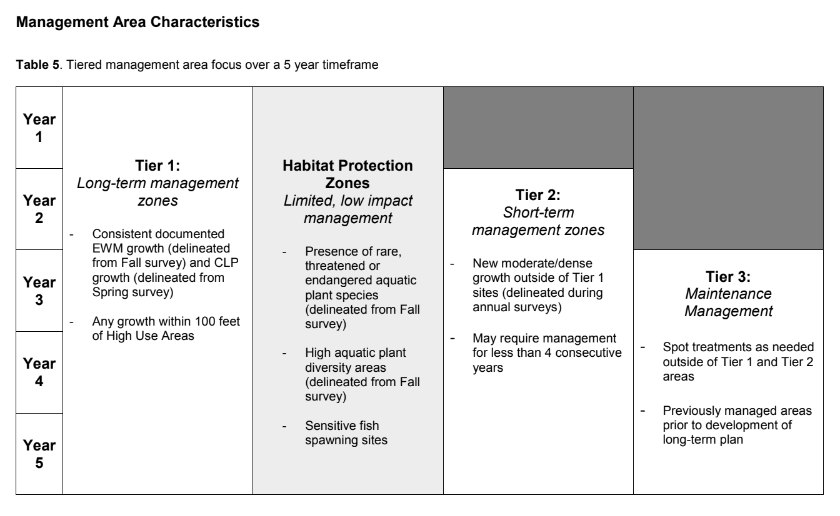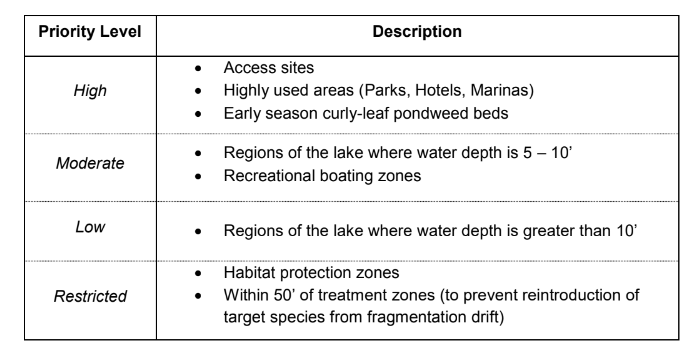Click here CL Management Plan to read the full plan document.
This plan was developed in response to discussions with he NYS DEC and others to clarify the goals of herbicide applications for Chautauqua Lake and to articulate a long range plan to achieve those goals. The plan is intended to be a living document which will be amended as needed over time as the plan is implemented. Success of this plan will transform our approach to lake management from simply targeting the worst areas from year-to-year, to a maintenance mode where only spot treatments will be needed to keep invasive aquatic vegetation in check.
The plan was prepared by the Aquatic Plant Management Program team at North Carolina State University and funded by the Chautauqua Lake Watershed & Management Alliance.
Plan Highlights
Problem Assessment
According to recent monitoring efforts, the macrophyte community at Chautauqua Lake is largely composed of Eurasian watermilfoil in the summer and fall months, and curly-leaf pondweed in the spring. The presence of these invasive species can disrupt the overall ecosystem function and additionally impact the local fishery, water quality, and recreational opportunities at the Lake. Starry stonewort also represents an emerging threat.
Vision
The goal of this project is to achieve a balanced and sustainable aquatic ecosystem at Chautauqua Lake. Objectives include reducing the nuisance level of invasive species and maintaining or increasing the relative distribution of native species. Integrated management of invasive species is encouraged as well as monitoring of both invasive and non-native species. Implementation of this plan will be based on set priorities and will occur in defined stages to ensure that progress is completed according to a systematic design. Annual reviews should be conducted of the plan, management effectiveness, and lake surveys.
Whole-Lake Management Strategy
Chautauqua Lake is naturally divided into two sections, the North and South Basins. Studies have determined that, while connected, the physical differences between the two basins can influence dynamics of fundamental, underlying ecosystem processes (Smith et al. 2020). These physical differences likely directly influence the aquatic plant communities as well, and as such, management strategies may need to differ when comparing North and South Basin needs. However, it should also be recognized that decisions regarding lake management should be unified in a whole-lake approach to maximize effort from all entities.
The 2017 Chautauqua Lake Macrophyte Management Strategy delineates the lake into sub-sections based off of shoreline use and highlights the need to consider human interaction along with environmental sensitivities when developing management options. While this strategy is effective at assessing options for specific, small-scale situations, it shifts the strategy away from a viewpoint that should be centered on plant ecology in order to meet the primary goals of long-term macrophyte management.
Specific Goals
The goals of this long-term plan include:
- Reduce the nuisance level of Eurasian Watermilfoil and Curly-Leaf Pondweed in the Chautauqua Lake system.
- Identify control measures for Starry Stonewort in Chautauqua Lake.
- Encourage native submersed aquatic vegetation species diversity throughout the system, with particular focus on South Basin assembly.
- Limit continued spread of non-native species in the Chautauqua Lake watershed
- Shift algal community away from cyanobacterial dominance
- Support the local fishery, especially the established game fish population
Plan Management
Stakeholder collaboration will be an important aspect of this plan, and as such, management decisions will need to be organized through a central entity. A Lake Manager dedicated to coordinating and tracking this work could be a valuable asset for long-term success and goal achievement.
Plan Review
To address the dynamic nature of long-term aquatic plant management projects, annual reviews of the management plan shall be conducted through a collaboration between the Lake Manager and the Executive Board to evaluate yearly outcomes, navigate forthcoming needs, and continue prioritization of management goals. The annual review should take place in the winter, such that necessary modifications can be put in place prior to the onset of the subsequent growing season.
Integrated Management Plan
This plan is divided into a sequential tiered system. Each tier builds upon each other, and as such, should be completed in the defined order. The plan will define and target long-term treatment areas, short-term management goals, and habitat protection areas.

